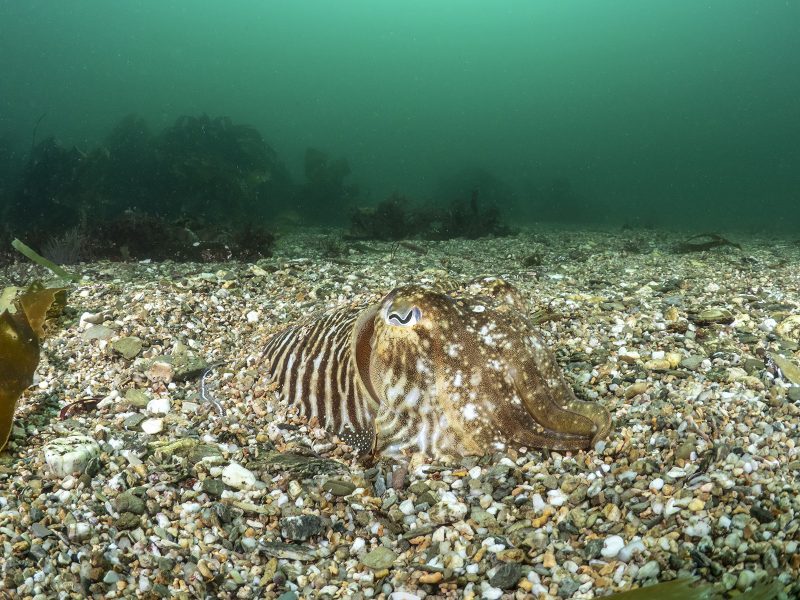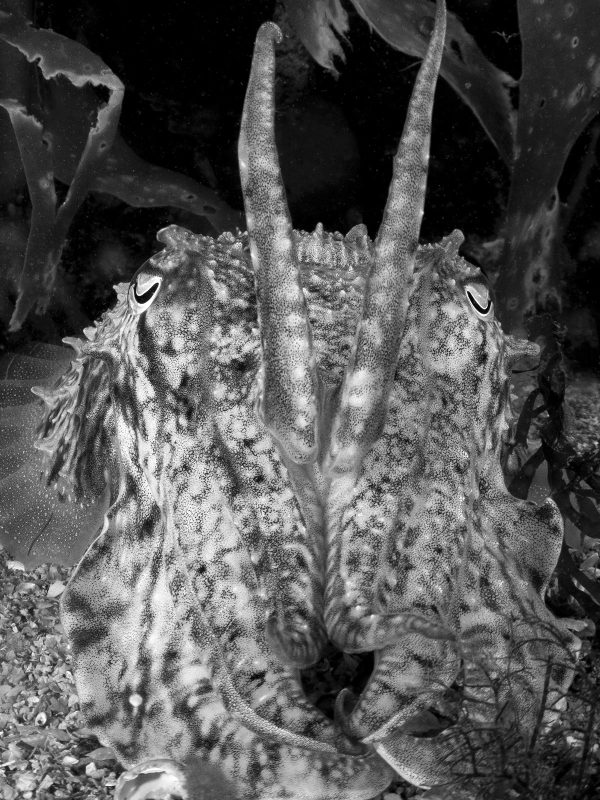How to Photograph Cuttlefish

Cuttlefish are cephalopods, like squid and octopus. There are over a hundred species of cuttlefish across the world’s oceans. They have a broad internal shell called a cuttlebone, which they use to control their buoyancy.
Cuttlefish have short, broad bodies and move slowly compared to other cephalopods. They propel themselves by flapping their skirt-like fin, or by jetting water from their siphon. They are highly intelligent and have the largest brain in comparison to body size of all invertebrates.


Despite being colourblind they have excellent vision, and can see contrasting light with their extremely well-developed eyes. Their pupils have a distinctive ‘w’ shape, which makes their eyes a great focal point in a photograph.
Cuttlefish are known as the chameleons of the sea, due to their ability to instantly change colour and texture to blend in with their environment. Their skin contains millions of coloured cells called chromatophores, which enable them to change their skin to communicate and camouflage.
Cuttlefish are great all-round subjects, and can be photographed well with both wide-angle and macro lenses.
Read more: Underwater Photograph Essential Techniques
How to Spot Cuttlefish
Encounters with cephalopods are often memorable. They are incredibly intelligent, and there is a certain feeling that they are observing you as much as you are observing them. Take time to admire their beauty and gain an understanding of their world. Sometimes, stopping to observe is the best way to learn about your subject and understand their behaviour.
The common cuttlefish (Sepiola officinalis) has a distinctive appearance. From a striped zebra pattern to a sandy colour, they have greater control of their colour and patterning than chameleons. They are able to instantly change their appearance to match their surroundings, which can make finding them quite the challenge.
On gravel or sandy ground, they camouflage themselves perfectly. Only the most eagle-eyed divers or snorkellers will spot them. The key is to move slowly and watch for movement. The chances are the cuttlefish will see you before you see them.
Here in the UK we also have a smaller species called little cuttlefish (Sepiola atlantica). These miniature cuttlefish are only a few centimetres long and are most commonly found in fine, sandy sediment, usually around seagrass.
They spend most of their time buried with only their eyes exposed. As with most marine life, the best way to find them is by staying still and watching for movement. As a defensive tactic, they release a tiny cloud of black ink and then quickly jet away.
However, if you see two small arms moving in the sand, this is probably your best chance to photograph one, as it will think it is hidden. The little cuttle is just as inquisitive as the larger species. By trying to approach carefully and avoiding spooking them, you have the best chance of them hanging around as you take your shots.
Read more: Ethics in Wildlife Photography
Using macro to photograph cuttlefish
Macro or super macro is a great way to get close and view the complex patterning of the cuttlefish. Close-up images allow you to capture the intricate detail of the chromatophores within the skin of the cuttlefish.
Approaching slowly and quietly will allow you to get close to the subject without spooking it. Another point to remember when approaching any marine life, is to give the individual time to adjust to your presence. The longer you stay close and remain calm and non-threatening, the more likely the subject is to trust you.
Read more: Underwater Photography Ethics and Code of Conduct
Using wide-angle and lighting techniques
Moving on from macro, cuttlefish make great subjects when using a wide-angle or fisheye lens. I find getting close and trying to achieve the close focus, wide-angle effect works well with these flamboyant creatures.
Typically, strobes would be used to photograph cuttlefish, as lighting can be difficult when the subject blends in with the background. A camouflaged subject, paired with a wide-angle or fisheye lens, can be hard to photograph. You need to spend time getting the lighting right and trying to aim your strobes before approaching your subject.
This will save precious time with the subject, and you can get your lighting right as soon as you get close to the subject. Under natural light, cuttlefish can look dull and blend in with their surroundings. Consider using a snoot or beam restrictors, in order to light only your subject and separate it from a conflicting background.
Read more: 5 Easy Ways to Avoid Backscatter in Underwater Photographs
Camera settings
With regards to settings, make sure you consider the background. If in a sandy or bright environment, use a little less power on your strobes. Remember that the sand will reflect the light and overexpose your image if too much strobe power is used.
If the cuttlefish is mid-water or near a reef, try to shoot slightly upwards, keeping the shutter speed low, and using it to control the colour of the water behind the subject.
If the cuttlefish is very well camouflaged and you’re finding it difficult to separate it from the background, then try to use lighting or the angle to isolate the subject. Isolating the subject will help to create a contrast, and draw the viewers’ attention to the area of interest.
In conclusion
As always, be aware of your actions underwater. Be a role model for other photographers and act in a way that won’t cause stress or damage to marine life. We need to respect the cuttlefish. So, if they show any signs of stress, back away and find another subject.
Cuttlefish are plentiful in summer and autumn, and it is common to see multiple individuals per dive. This means there is plenty of choice if one subject is being particularly difficult to work with. Have variety in your images and experiment with wide-angle, macro, and lighting techniques to see which techniques work best for you.
If you find a heavily camouflaged cuttlefish, don’t swim past and look for an easier subject. Their camouflage is an interesting behaviour to photograph. Not only is it spectacular to witness but, by getting creative with your settings and lighting, it is possible to draw attention to a cuttlefish in even the most challenging environments.











